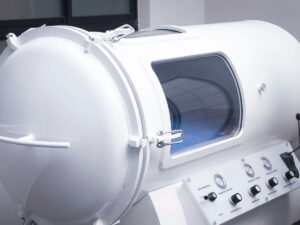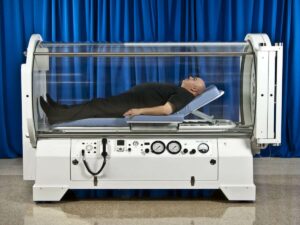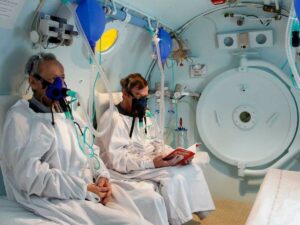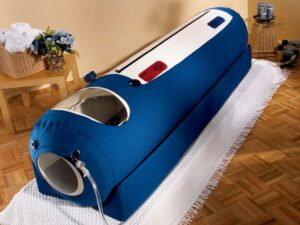Wondering how athletes can revolutionize their performance and recovery? Athletes constantly face the challenge of optimizing their performance and recovering from intense workouts and injuries to stay at the top of their game. Traditional recovery methods often take time and may not yield desired results.
Enter hyperbaric chambers, the cutting-edge solution that is gaining immense popularity among athletes for their recovery and performance-boosting potential. In this comprehensive guide, we will delve into the world of hyperbaric chambers for athletes, exploring the science behind the therapy, its benefits in treating sports injuries, and how it accelerates recovery.
Buckle up and read on!
1. Understanding Hyperbaric Chambers
Hyperbaric chambers are specialized medical devices used to administer hyperbaric oxygen therapy (HBOT), a treatment that involves breathing pure oxygen in a pressurized environment. To know more about that, here is a brief overview:
What is a Hyperbaric Chamber?
A hyperbaric chamber is a specially designed, pressurized environment that contains higher levels of oxygen than normal air. Athletes utilize hyperbaric chambers to optimize their performance, speed up the recovery time from injuries, and promote overall well-being. These chambers come in two main types: monoplace, designed for individual use, and multiplace, capable of accommodating multiple individuals simultaneously.

How Does a Hyperbaric Chamber Work?
The hyperbaric chamber operates on the principle of delivering high-pressure oxygen to the body’s tissues and cells. During a session, the athlete breathes in pure oxygen, allowing the lungs to absorb a significantly higher amount of oxygen than regular air.
This increased oxygen supply boosts the immune system, stimulates healing processes, and aids in the body’s recovery from intense workouts and injuries. By creating an oxygen-rich environment, hyperbaric chambers, for instance, offer athletes a unique approach to optimize their performance and overall health.
2. Benefits of Hyperbaric Therapy for Athletes
I have witnessed that for athletes, hyperbaric therapy offers a range of potential benefits to enhance their performance and overall well-being. Here are some important key points to take note of:
Improved Recovery and Healing
Hyperbaric oxygen therapy enhances the body’s natural healing processes by increasing the oxygen supply to damaged tissues and cells. This accelerated healing helps athletes recover from injuries more swiftly, allowing them to return to peak performance levels in less time. I believe with the support of hyperbaric chambers, athletes can efficiently manage sports-related injuries, and having a home hyperbaric chambers can provide them with convenient access to this beneficial treatment.
Enhanced Athletic Performance
By promoting increased oxygen levels in the bloodstream, hyperbaric chambers contribute to enhanced physical endurance, improved stamina, and heightened mental focus. Athletes who incorporate hyperbaric oxygen therapy into their training routines, for example, experience increased energy levels, enabling them to perform at their best during demanding competitions and training sessions.

Prevention of Sports-related Injuries
Regular use of hyperbaric chambers can help prevent sports-related injuries by strengthening the body’s immune response and reducing inflammation. The oxygen-rich environment within the chamber aids in tissue repair, minimizing the risk of repetitive strain injuries and overuse injuries commonly encountered by athletes. For example, some professional basketball players reported experiencing significant benefits in using HBOT.
Boosted Cognitive Functions
One significant advantage of hyperbaric therapy for athletes often overlooked is the enhancement of cognitive functions. Sports often require quick decision-making skills, the ability to focus intensely, and superior hand-eye coordination. Hyperbaric therapy enhances brain functionality by improving oxygen distribution and stimulating the formation of new blood vessels in the brain.
Reduced Fatigue
Another notable benefit is the reduction of fatigue and enhancement of stamina. Sports require athletes to push their bodies to the limit, which can often result in exhaustion and decreased performance over time. Hyperbaric therapy aids in mitigating these effects by promoting the production of adenosine triphosphate (ATP), a compound that fuels cellular metabolism and muscle contractions.
3. Types of Hyperbaric Chambers
Hyperbaric oxygen therapy (HBOT) is a cutting-edge treatment used to accelerate healing and promote recovery in various medical conditions. At OxygenArk, there are three main types of hyperbaric chambers available. Each type serves a specific purpose and offers unique advantages for patients undergoing hyperbaric oxygen therapy. See the following below:
Monoplace Hyperbaric Chambers
Monoplace chambers are designed to accommodate a single patient at a time. They are typically enclosed in an acrylic tube and provide a pressurized environment for patients to breathe 100% pure oxygen. I believe monoplace chambers are commonly found in both hospital and private office settings, and they are ideal for individualized treatment sessions at specific atmospheric pressures, ranging from 1.5 to 3.0 ATA.

Multiplace Hyperbaric Chambers
Larger and can hold multiple patients simultaneously are multiplace hyperbaric chambers. These resemble a small pressurized room, similar to an airplane cabin, and they deliver high-pressure oxygen through masks or lightweight, transparent hoods placed over the patients. Multiplace chambers are used in medical facilities and offer the advantage of treating several patients at once, making them more cost-effective and efficient.

Portable Hyperbaric Chambers
Portable or soft chambers are non-medical grade chambers made from elastic plastic called TPU. They are chambers approved for home use and are pressurized to mild HBOT pressure levels of up to 1.3 ATA. Portable chambers are accessible to patients for personal use, and they have become increasingly popular due to their convenience and potential for neurocognitive recovery and cognitive optimization.

4. The Procedure: What to Expect in a Hyperbaric Chamber Session
Hyperbaric chamber sessions are safe, non-invasive, and well-established medical treatments used to enhance recovery and healing. The procedure involves breathing 100% oxygen at elevated atmospheric pressure, which allows the lungs to absorb more oxygen, promoting tissue repair and fighting infections. Here’s what to expect during a hyperbaric chamber session:
Before the Session
Prior to the session, patients will undergo a comprehensive evaluation by a healthcare provider to determine the appropriate treatment plan. Based on my experience, safety measures will be explained, and any potential contraindications will be assessed to ensure the patient’s well-being during the therapy.
During the Session
In the hyperbaric chamber, patients will be positioned based on the type of chamber being used. There is a monoplace chamber that accommodates one person who lies down or reclines, while multiplace chambers can hold multiple patients sitting in chairs. The chamber will be sealed and gradually pressurized to the prescribed level, and patients will breathe in pure oxygen through masks or hoods.
After the Session
Once the hyperbaric session is complete, the chamber will be depressurized, and patients can safely exit the chamber. A friend of mine has undergone this and according to her, depending on the specific condition being treated, patients may require multiple sessions over a designated period for optimal results.
5. Risks and Side Effects of Hyperbaric Therapy
Hyperbaric therapy, while generally safe and well-tolerated, may carry some risks and side effects that athletes, business owners, and experts should be aware of. Everyone must be encouraged to consult with a qualified healthcare professional before undergoing hyperbaric therapy to assess their suitability for treatment and minimize potential risks. Here are some possible risks and side effects:
- Claustrophobia: Some individuals may experience feelings of claustrophobia or anxiety when confined inside the hyperbaric chamber, especially if they have a fear of small or crowded spaces. However, newer chambers made from clear acrylic offer visibility and may help alleviate this issue.
- Changes in Vision: In rare cases, HBOT may cause temporary changes in vision, particularly in the shape of the lens in the eye. This can lead to worsening nearsightedness or improvement in presbyopia, the inability to focus on nearby objects due to age-related lens changes. These vision changes typically resolve within six to eight weeks after treatment.
- Oxygen Poisoning: To prevent oxygen toxicity, patients may need to take short breaks during therapy and breathe normal air. Although oxygen poisoning is rare in standard HBOT treatments, it is essential for healthcare providers to monitor oxygen levels and manage exposure accordingly.
- Ear damage: During HBOT, the air pressure inside the chamber is significantly higher than normal. This pressure change can cause barotrauma, which refers to injuries to the ears, sinuses, or lungs due to pressure differentials. Individuals may experience ear pain, popping sensations, or sinus discomfort.
The table presents an overview of the risks and side effects of hyperbaric therapy, along with management and precautions to enhance safety and awareness for athletes, business owners, and experts considering this treatment.
| Risk/Side Effect |
Description |
Management/Precautions |
| Claustrophobia |
Some individuals may experience feelings of claustrophobia or anxiety when confined inside the hyperbaric chamber, especially if they have a fear of small or crowded spaces. |
Use newer chambers made from clear acrylic to offer visibility and potentially alleviate claustrophobia. |
| Changes in Vision |
In rare cases, HBOT may cause temporary changes in vision, particularly in the shape of the lens in the eye, leading to worsening nearsightedness or improvement in presbyopia. |
Inform patients about the possibility of vision changes and reassure them that these changes usually resolve within six to eight weeks after treatment. |
| Oxygen Poisoning |
To prevent oxygen toxicity, patients may need to take short breaks during therapy and breathe normal air. Rare in standard HBOT treatments but requires careful monitoring. |
Healthcare providers must monitor oxygen levels and adjust exposure accordingly to minimize the risk of oxygen toxicity. |
| Ear Damage |
The pressure change inside the hyperbaric chamber can cause barotrauma, leading to injuries in the ears, sinuses, or lungs, resulting in ear pain, popping sensations, or sinus discomfort. |
Instruct patients on how to equalize ear pressure during the therapy. Avoid HBOT if experiencing congestion or respiratory infections to reduce the risk of ear damage. |
6. Access and Availability
Athletes can access hyperbaric therapy at specialized medical centers, sports clinics, and certain hospitals that offer HBOT services. The availability of hyperbaric chambers may vary based on the region and demand for treatment. While the cost of hyperbaric therapy can vary depending on the location and type of chamber used, many athletes find the potential benefits of this treatment to be well worth the investment. See the ff. below:
How and Where Athletes Can Access HBOT
Hyperbaric therapy is typically accessible through medical facilities, specialized clinics, and hospitals equipped with hyperbaric chambers. Athletes can access HBOT by consulting sports medicine practitioners, rehabilitation centers, or hyperbaric medicine specialists who offer the treatment. Some sports teams and organizations invest in hyperbaric chambers for their athletes to support injury recovery and performance enhancement.
The Cost of Hyperbaric Therapy
The cost of hyperbaric therapy can vary widely based on the geographical location, the specific facility, the purpose of the treatment, and whether it is covered by insurance. However, as of my knowledge, the cost for a single hyperbaric oxygen therapy session typically ranged between $200 and $2500 out-of-pocket. For a full course of treatment (20-40 sessions), costs could range from $4000 or more.
Pros and Cons of Hyperbaric Therapy for Athletes
Hyperbaric therapy for athletes comes with its own set of advantages and considerations. Consulting with healthcare professionals and experts in sports medicine can help athletes make informed decisions about incorporating hyperbaric therapy into their training and recovery regimen. Here are some important details to keep at the forefront:
Pros
-
Accelerated Recovery
Hyperbaric therapy facilitates faster recovery for athletes by increasing oxygen delivery to tissues. This leads to enhanced cellular repair, reduced inflammation, and improved formation of new blood vessels, allowing athletes to recover more swiftly from intense training sessions and injuries.
-
Reduced Inflammation and Swelling
Intense physical activity can lead to tissue inflammation and swelling, hindering an athlete’s performance and recovery. HBOT effectively reduces inflammation by enhancing oxygenation and improving lymphatic drainage, alleviating swelling and discomfort, and enabling athletes to perform at their best.
-
Enhanced Tissue Healing
HBOT promotes tissue healing by providing essential oxygen for cellular repair and regeneration. This therapy stimulates healthy tissue growth, reduces the risk of infection, and accelerates overall healing, allowing athletes to resume training and competition schedules sooner.
-
Improved Energy Production and Endurance
Optimal oxygen utilization is vital for energy production during physical exertion. HBOT enhances cellular metabolism and ATP production, the primary energy source for muscle contractions. This boosts endurance, enabling athletes to perform at higher intensities for extended periods.
-
Enhanced Cognitive Function
Cognitive function is crucial for athletes who require sharp mental acuity and focus during competitions. HBOT enhances cognitive function by providing increased oxygen levels to the brain, improving concentration, mental clarity, and decision-making skills.
Cons
-
Cost
Hyperbaric therapy is a valuable treatment option for athletes seeking to enhance performance and expedite recovery. However, it’s essential to acknowledge that the cost of hyperbaric treatment sessions can be a factor for some athletes. The expenses associated with hyperbaric oxygen therapy can vary depending on the facility and the specific condition being treated
-
Limited Availability
Despite the growing popularity of hyperbaric therapy, its availability may not be widespread in all regions. This limitation could pose challenges for athletes seeking convenient access to this treatment option. Regions with limited hyperbaric chambers may require athletes to travel or find alternative solutions to address their recovery needs.
-
Oxygen Toxicity Risks
Prolonged exposure to high levels of oxygen during HBOT can lead to oxygen toxicity, which may result in seizures, lung damage, or other adverse effects. Athletes need to follow appropriate treatment protocols and consult qualified healthcare professionals to mitigate these risks.
-
Time Commitment
Hyperbaric therapy often requires multiple sessions over time to achieve optimal results. For athletes with demanding training and competition schedules, dedicating time to these sessions might pose challenges. However, the potential benefits of enhanced recovery and improved performance may outweigh the time commitment for many athletes.
Dive Deeper Into Our Resources
Looking for more diverse product options? Browse through our handpicked selections:
For some insightful reads, we’ve curated a list of recommended articles just for you:
Still haven’t found what you’re looking for? Don’t hesitate to contact us. We’re available around the clock to assist you.
Conclusion
In this in-depth exploration of hyperbaric chambers for athletes, we have delved into the remarkable benefits of hyperbaric oxygen therapy (HBOT) in enhancing athletic performance and expediting recovery. By immersing athletes in pressurized chambers filled with pure oxygen, HBOT promotes increased oxygen levels in the bloodstream, aiding in healing and reducing inflammation.
For any queries or further information don’t hesitate to reach out to us. We at OxygenArk are always ready to embark on a transformative journey to redefine athletic performance and businesses. Let’s explore the world of hyperbaric oxygen therapy and elevate business offerings to new heights. Together, we can revolutionize athletic excellence. Contact us today!





